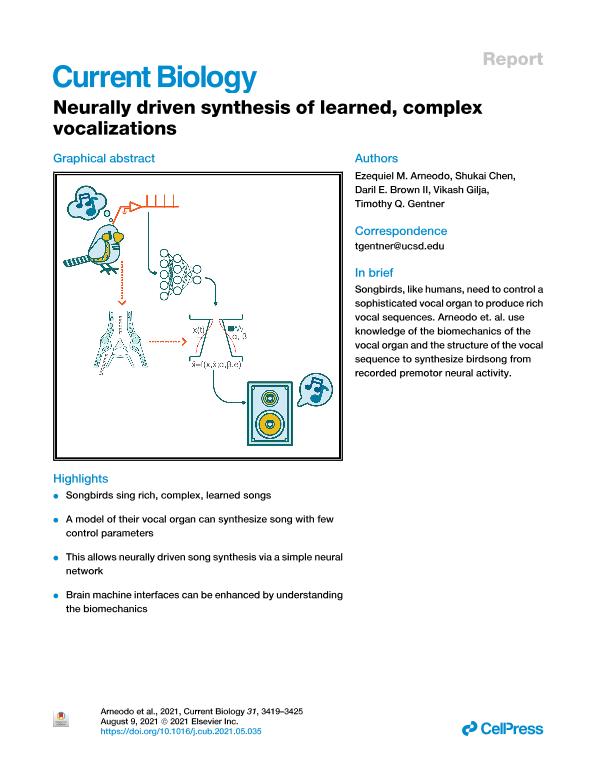Mostrar el registro sencillo del ítem
dc.contributor.author
Arneodo, Ezequiel Matías

dc.contributor.author
Chen, Shukai
dc.contributor.author
Brown, Daril E.
dc.contributor.author
Gilja, Vikash
dc.contributor.author
Gentner, Timothy Q.
dc.date.available
2022-11-25T16:18:37Z
dc.date.issued
2021-08
dc.identifier.citation
Arneodo, Ezequiel Matías; Chen, Shukai; Brown, Daril E.; Gilja, Vikash; Gentner, Timothy Q.; Neurally driven synthesis of learned, complex vocalizations; Cell Press; Current Biology; 31; 15; 8-2021; 3419-3425
dc.identifier.issn
0960-9822
dc.identifier.uri
http://hdl.handle.net/11336/179036
dc.description.abstract
Brain machine interfaces (BMIs) hold promise to restore impaired motor function and serve as powerful tools to study learned motor skill. While limb-based motor prosthetic systems have leveraged nonhuman primates as an important animal model,1–4 speech prostheses lack a similar animal model and are more limited in terms of neural interface technology, brain coverage, and behavioral study design.5–7 Songbirds are an attractive model for learned complex vocal behavior. Birdsong shares a number of unique similarities with human speech,8–10 and its study has yielded general insight into multiple mechanisms and circuits behind learning, execution, and maintenance of vocal motor skill.11–18 In addition, the biomechanics of song production bear similarity to those of humans and some nonhuman primates.19–23 Here, we demonstrate a vocal synthesizer for birdsong, realized by mapping neural population activity recorded from electrode arrays implanted in the premotor nucleus HVC onto low-dimensional compressed representations of song, using simple computational methods that are implementable in real time. Using a generative biomechanical model of the vocal organ (syrinx) as the low-dimensional target for these mappings allows for the synthesis of vocalizations that match the bird's own song. These results provide proof of concept that high-dimensional, complex natural behaviors can be directly synthesized from ongoing neural activity. This may inspire similar approaches to prosthetics in other species by exploiting knowledge of the peripheral systems and the temporal structure of their output.
dc.format
application/pdf
dc.language.iso
eng
dc.publisher
Cell Press

dc.rights
info:eu-repo/semantics/openAccess
dc.rights.uri
https://creativecommons.org/licenses/by-nc-sa/2.5/ar/
dc.subject
BIOPROSTHETICS
dc.subject
BIRDSONG
dc.subject
BRAIN MACHINE INTERFACES
dc.subject
ELECTROPHYSIOLOGY
dc.subject
NEURAL NETWORKS
dc.subject
NONLINEAR DYNAMICS
dc.subject
SPEECH
dc.subject.classification
Otras Ciencias Físicas

dc.subject.classification
Ciencias Físicas

dc.subject.classification
CIENCIAS NATURALES Y EXACTAS

dc.title
Neurally driven synthesis of learned, complex vocalizations
dc.type
info:eu-repo/semantics/article
dc.type
info:ar-repo/semantics/artículo
dc.type
info:eu-repo/semantics/publishedVersion
dc.date.updated
2022-09-20T15:47:23Z
dc.journal.volume
31
dc.journal.number
15
dc.journal.pagination
3419-3425
dc.journal.pais
Estados Unidos

dc.description.fil
Fil: Arneodo, Ezequiel Matías. University of California; Estados Unidos. Consejo Nacional de Investigaciones Científicas y Técnicas. Centro Científico Tecnológico Conicet - La Plata. Instituto de Física La Plata. Universidad Nacional de La Plata. Facultad de Ciencias Exactas. Instituto de Física La Plata; Argentina
dc.description.fil
Fil: Chen, Shukai. University of California; Estados Unidos
dc.description.fil
Fil: Brown, Daril E.. University of California; Estados Unidos
dc.description.fil
Fil: Gilja, Vikash. University of California; Estados Unidos
dc.description.fil
Fil: Gentner, Timothy Q.. The Kavli Institute For Brain And Mind; Estados Unidos. University of California; Estados Unidos
dc.journal.title
Current Biology

dc.relation.alternativeid
info:eu-repo/semantics/altIdentifier/url/https://doi.org/10.1016/j.cub.2021.05.035
dc.relation.alternativeid
info:eu-repo/semantics/altIdentifier/doi/http://dx.doi.org/10.1016/j.cub.2021.05.035
Archivos asociados
